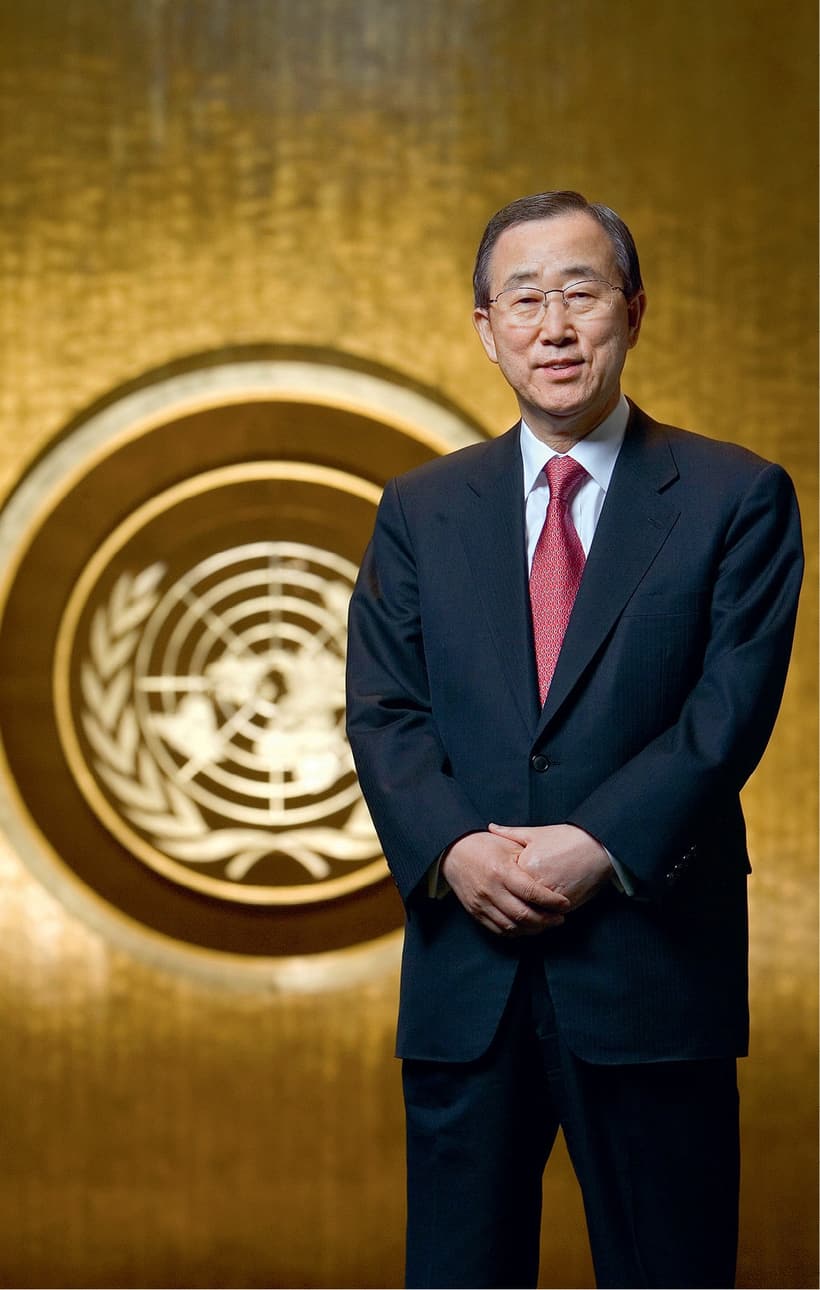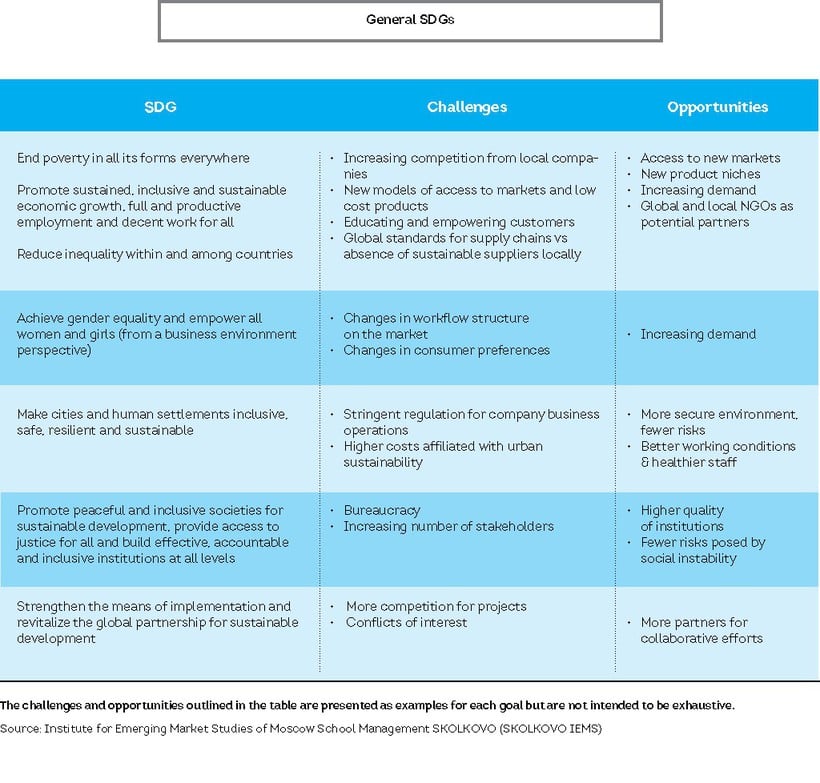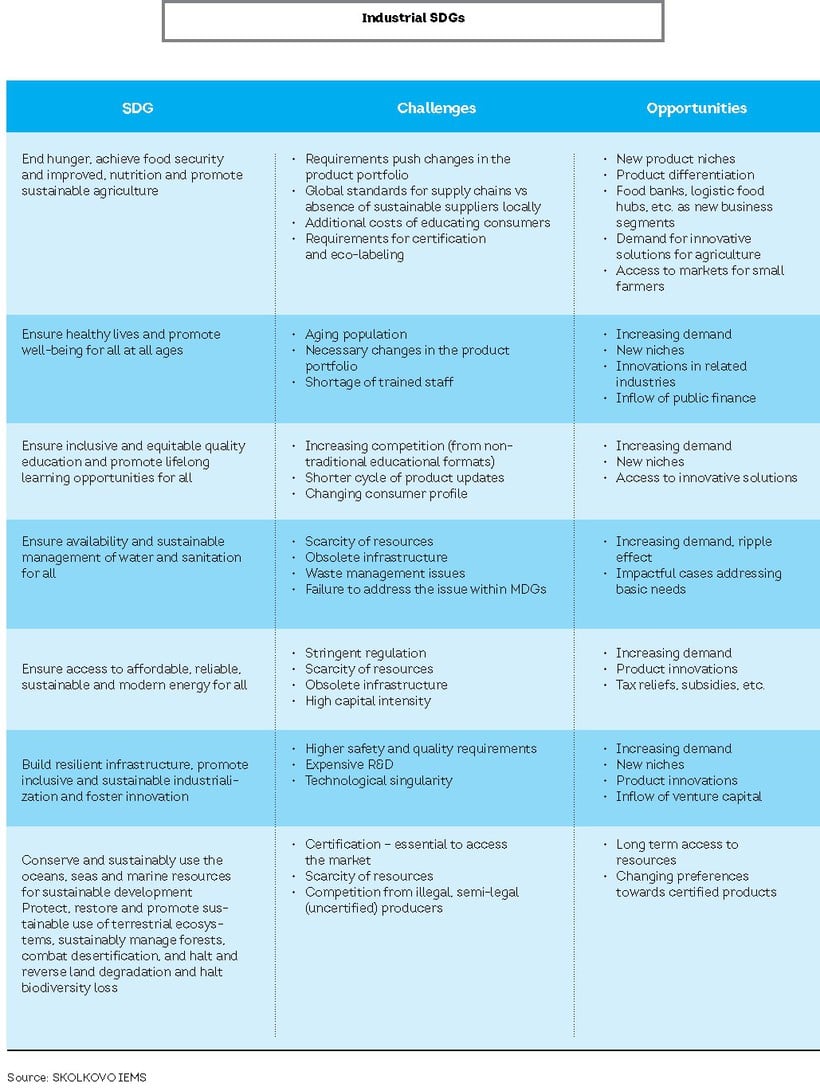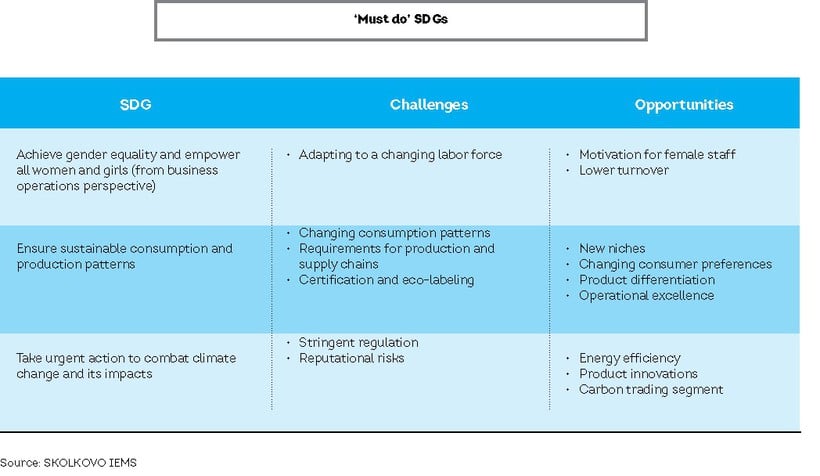A Revolution in Sustainability
The private sector is expected to play a proactive role in helping to achieve the UN’s Sustainable Development Goals by 2030. This will significantly affect the business environment in international markets. As well as imposing additional requirements of businesses, it also offers new long-term opportunities for sustainable growth. The most far-sighted companies can seize a leading role in formulating future development agenda by creating competitive business advantages.
In September 2015 the UN General Assembly adopted 17 Sustainable Development Goals (SDGs) which will define the development landscape for the next 15 years (2015-2030). Compared with the Millennium Development Goals (MDGs), which covered 2000-2015 and did not rely on active business involvement, these SDGs are expected to offer the private sector unprecedented opportunities to participate in the process of shaping and leveraging the international development agenda. At the same time, SDGs set higher requirements and expectations for corporate behavior at global, national and local levels. The current global context and the new SDGs define the future operational landscape for businesses, shifting internal perceptions of sustainability from attractive extras to the very core of business strategies and daily operations. But how have the development goals changed to prompt more active business involvement? What are the business challenges and opportunities that SDGs will bring? How can companies respond to this demanding new reality in order to generate sound and impactful business cases, especially in emerging markets where neither the business environment nor customer preferences are sufficiently mature?
RESULTS AND RATIONALE FOR A NEW PARADIGM
As 2015 marked the end of the MDG era, no discussion about the post-2015 development agenda is possible without reflecting on the MDGs, evaluating the results and assessing the today’s development context. Eight Millennium Development Goals were a part of the “Millennium Declaration” that was presented by Kofi Annan in September 2000.
Significant progress has been achieved in most areas. Extreme poverty in developing countries, for example, was halved between 1990 and 2015 from 47% to around 14%1. Globally, the number of people living below the international poverty line fell from 1.9 billion in 1990 to 836 million in 2015. The proportion of undernourished people in developing regions has fallen by almost half since 1990s. Child mortality rates have come down significantly: child death rates have fallen by more than half, dropping from 90 to 43 deaths per 1,000 live births. Access to safe water and enrolment in primary education have improved. In 2015, 91% of the global population use an improved drinking water source, compared to 76% in 1990. The primary school net enrolment rate in developing regions has reached an estimated 91% in 2015, up from 80% in 1990.
At the same time, MDGs were less effective in areas such as sanitation. Between 1990 and 2015, the proportion of the global population using an improved sanitation facility increased from 54% to 68%, but the target level was not achieved. In 2015, 2.4 billion people still use unimproved sanitation facilities. No special global fund for clean water and sanitation has been established within the MDG agenda. Education, especially life-long education beyond primary level, was also not quite as high on the global agenda and not as well financed as global public health. As a result, gains in health have outpaced gains in education.
Overall, MDGs have been successful at focusing the attention of the global community on eight specific goals, mobilizing vast financial resources and great expertise, as well as establishing institutional infrastructure and governance mechanisms to address these goals. They have also contributed to the accumulation of a sound knowledge base on specific themes, such as food security, fighting diseases, etc. Finally, these goals provided a critical social impetus; they were the first attempt to create a shared global vision for sustainable development. The 2015 global environment is very different than the 2000 one. It is more globalized, more interdependent, more urban, more middle class, more vulnerable and more constrained in its resources. Despite certain positive results and achievements, today’s sustainable development challenges are much broader than the scope of MDGs, and that requires a new approach. Several reasons for the emergence of a new agenda can be outlined here.
Compared with the Millennium Development Goals (MDGs), which covered 2000-2015 and did not rely on active business involvement, these SDGs are expected to offer the private sector unprecedented opportunities to participate in the process of shaping and leveraging the international development agenda. At the same time, SDGs set higher requirements and expectations for corporate behavior at global, national and local levels. The current global context and the new SDGs define the future operational landscape for businesses, shifting internal perceptions of sustainability from attractive extras to the very core of business strategies and daily operations
First of all, there is an ever-increasing number of problematic areas requiring the attention of the global community, and despite the efforts within the MDG framework, progress has not managed to outpace the emergence of new ‘material’ threats. While MDGs have, indisputably, delivered transformational results in many countries, this capacity-building assistance extended to developing countries hit by AIDS and absolute poverty has not addressed all the challenges that the world faces today. So the new SDG paradigm, by definition, had to aim for more ‘balanced’ and inclusive sustainable development across a more diverse group of stakeholders. Unlike MDGs, which applied largely to poor countries (i.e. the least developed countries (LDCs) and heavily indebted poor countries (HIPCs)) and referenced the rich countries mainly as donors, SDGs are universally applicable across all countries and stakeholders.
 Second, these new ‘material’ threats create far greater operational risks for the private sector. It should be noted that MDGs were designed at a time when the now-familiar concepts of ‘planetary boundaries’, ‘low-carbon economy’ and ‘green economy’ heard in all countries and businesses had yet to be coined and formalized. The coming 15-year period, 2015-2030, will be distinguished by a drastically higher human impact on the physical Earth. Business-as-usual is not feasible due to the catastrophic environmental threats generated by these cause-effect factors and the increasing frequency of extreme weather events. For example, businesses have not anticipated that climate change might be ‘material’ across all business operations and all countries where the company has a presence, and that climate-related risks might have associated costs. In the early 2000s businesses felt responsible for aiding vulnerable populations in Africa, but those activities were a part of a corporate social responsibility (CSR) agenda. Climate change, on the other hand, goes beyond CSR. It represents a unifying agenda for all governments and private sector actors. Hence businesses have to join the global development movement, as measurable results can be achieved only in collaboration with others.
Second, these new ‘material’ threats create far greater operational risks for the private sector. It should be noted that MDGs were designed at a time when the now-familiar concepts of ‘planetary boundaries’, ‘low-carbon economy’ and ‘green economy’ heard in all countries and businesses had yet to be coined and formalized. The coming 15-year period, 2015-2030, will be distinguished by a drastically higher human impact on the physical Earth. Business-as-usual is not feasible due to the catastrophic environmental threats generated by these cause-effect factors and the increasing frequency of extreme weather events. For example, businesses have not anticipated that climate change might be ‘material’ across all business operations and all countries where the company has a presence, and that climate-related risks might have associated costs. In the early 2000s businesses felt responsible for aiding vulnerable populations in Africa, but those activities were a part of a corporate social responsibility (CSR) agenda. Climate change, on the other hand, goes beyond CSR. It represents a unifying agenda for all governments and private sector actors. Hence businesses have to join the global development movement, as measurable results can be achieved only in collaboration with others.
Third, in the light of growing populations, governments and businesses are increasingly faced with the problem of satisfying growing consumption. Health-related MDG deliverables have directly contributed to reduced global mortality rates, and, thus, to a new problem of a rapidly growing population. With a world population now at 7.2 billion people and an annual gross domestic product (GDP) of nearly $90 trillion, the world economy is already exceeding several of the Earth’s “planetary boundaries”. At the moment the global population consumes roughly 1.25 of the Earth’s available resources, and that is an unsustainable trend. The demographic structure of the world’s population has also changed. For example, the number of people in the working middle class, living on more than $4 a day has almost tripled between 1991 and 2015, which means increasing and less sustainable consumer preferences.
Today’s world is a different place, so Sustainable Development Goals must take into account changes in the global context. Unlike the earlier MDGs, 17 new SDGs were developed using a bottom-up approach, relying on active involvement and consultations with NGOs, business, scientists, the academic community, etc. This updated agenda is much more inclusive and covers every individual on the planet (‘opportunities for all’, ‘for all at all ages’, etc.). It also includes a broader set of goals including social, environmental, technological and infrastructural ones.
The good news for private sector players derives from the fact that business-related goals are included in the global sustainability agenda. More stakeholders are identified for collaborative efforts in the businessplaying field, and that offers a broader range of opportunities. The bad news stems from the higher expectations placed upon businesses by regulators, NGOs, customers and communities. Leaving aside for a moment the concept of ‘business social responsibility’ and corporate charity initiatives, companies need to be pragmatic and build sound business cases in order to succeed. What are the new ‘must-do’ issues that a sustainable business has to address, following the SDG vision? What are the potential opportunities for building sound business cases, using sustainability as a core basis?
NEW AGENDA: CHALLENGES
AND OPPORTUNITIES FOR BUSINESS
When looking for a business case, companies usually address sustainability issues while taking into account the ‘scope of influence’. Where you have a stake, it makes sense to play in the game. SDGs do provide opportunities for business, but they differ widely and should be addressed ndividually. Approaches to structuring SDGs and implementing them into corporate strategies vary widely from company to company, but there are still three identifiable groups: (1) general SDGs that primarily influence businesses through changes in the business environment and create ‘hidden’ opportunities; (2) industrial SDGs that have the biggest influence on companies operating in related sectors; (3) ‘must do’ SDGs where expectations from stakeholders would be similar for all companies.

General SDGs
What can businesses do towards building social capacity in line with these general Sustainability Development Goals? These particular goals appear to be of little relevance to the private sector, as they concern development macroeconomic topics, such as poverty, income inequality, economic growth and productive employment. These goals lay high expectations primarily at the door of national governments, as they influence public institutions and public policy-making processes. Nevertheless, all these activities directly influence the business environment, improving conditions for business operations and helping to unlock new markets. Some forward-thinking companies have already started their quest to bring development to the ‘bottom of the pyramid’ as a part of their corporate strategy. The first-mover effect suggests companies that successfully fulfil the needs of the next billion consumers in the emerging and developing countries would reap the benefits.
Mondi, an international packaging and paper group, launched its Mondi Zimele initiative in South Africa in 2007. The initiative aims to provide small business loans, start-up capital and business development expertise to new businesses in segments related to packaging and paper. It has three core business objectives: to develop sustainable suppliers in the supply network, to encourage job creation and local economic development, and to increase the availability of sustainable fiber for the company’s mills. In 2012, the company established the Mondi Zimele Jobs Fund with the Development Bank of South Africa (DBSA) to support local job creation. The program has supported 101 small and medium community enterprises, with a collective average annual turnover of around 30 million euros and with an employment footprint of more than 2,600 people.
Cisco, an American multinational technology company, funded training for master trainers and provided technology and mentoring to Siyafunda CTC, a network of South African community knowledge centers, where people can access computers, the internet and other digital technologies. In 2009, Siyafunda partnered with Cisco to transform 3 telecenters in Palmridge, Wattville, and Batho Pele. Siyafunda centers have become incubators for economic developments, where social entrepreneurs who can use technology access a massive support structure from the NGO partners and Cisco, a global corporation. Siyafunda’s vision is “empowering, educating and e-connecting communities”.
Sustainable Development Goals are an instrument for transforming the best practices and innovative business models developed by today’s pioneers into mainstream ideas. As more companies act in the same sustainable manner and address the same beneficiaries, the higher the competition will become. So there are still incentives for businesses to explore new sustainability opportunities and innovate in this field. There is the potential for the most forward-thinking companies to lead the future development agenda, so that best practices implemented by 2030 can go on to define the post-2030 business landscape
Since 2009, Barclays, a UK-based banking and financial services company, has worked with two British NGOs – CARE International and Plan – in a unique partnership to improve access to financial services in developing markets by taking a savings-led, rather than credit-led approach to microfinance. The ‘Banking on Change’ initiative aims to improve the quality of life of the world’s poorest people living on less than $2 a day. The program runs in seven countries: Egypt, Ghana, India, Kenya, Tanzania, Uganda and Zambia.
While gender equality has become an integral part of any corporate DNA, empowerment of external female stakeholders is still not a widespread practice in the global sustainability agenda of multinational corporations. US-based sportswear company Nike started investing in sustainability initiatives designed to benefit teenage girls via a foundation in 2004. In 2008 the Girl Effect movement was launched to global leaders at the World Economic Forum in Davos as the NoVo Foundation and Nike Foundation committed $100M for girls. According to the Girl Effect, when a girl is better educated, has access to sexual and reproductive healthcare information and services, has access to and control of her own economic assets, is safe from violence and exploitation, and has the capability and confidence to make positive choices, she can break the cycle of poverty, also lifting families and communities out of poverty.

All the aforementioned case studies are built around either revenue-based (e.g. Barclays work on increasing the portfolio of ‘bankable’ customers) or cost-based (e.g. Mondi’s sustainable sourcing initiatives focused on empowering its suppliers) sustainability strategies as their underlying business model. Entering new markets can be costly for companies, still more costly with global efforts within this group of goals. Businesses need to experiment, as the question of choosing the right time to enter the market before it has reached the saturation stage has ‘ripened’. To do this, companies need a market presence and established relationships with local communities.
Industrial SDGs
Industry-specific SDGs will have the greatest influence on companies operating in the sectors where the respective resources are relevant to the core product, e.g. energy, fuel , food and beverage, fishing, forestry, pulp, paper, packaging, water, construction materials, healthcare, personal care, education, IT, etc.
In the food and beverage industry, for example, sustainable sourcing goals are often challenged by the immaturity of local suppliers. In late 2011, Cargill, a US privately-held agribusiness, launched a sustainable agriculture project in China in partnership with Coca-Cola and WWF that aims to help local farmers increase corn yields, reduce post-harvest waste and minimize their environmental footprint. Through this initiative, Cargill fulfils its commitment to a responsible supply chain and agricultural modernization in China. The project began with 10 demonstration farms, increasing to 30, focusing on improving seed selection and row spacing, and testing soil to guide the use of fertilizers. For food and beverage companies the underlying business model is primarily cost-based, as they work towards achieving sustainability along the supply chains.
As companies are expected to act in a responsible manner, today any breach of public trust can potentially destroy a corporate image and bring a company under massive scrutiny. In 2001, Enron’s accounting scandal ultimately led to the company filing for bankruptcy. Being unsustainable, unethical and unaccountable has proven to be expensive for businesses on several occasions. In recent months Volkswagen’s potential liability to the US Environmental Protection Agency (EPA) was estimated at $18 billion
Healthcare-related goals provide space for collaborative efforts and innovative business models for pharmaceutical companies and medical equipment suppliers. Examples include addressing the shortage of anti-malaria medicines due to poor inventory systems (e.g. Novartis with Vodafone, IBM, Ministry of Health of Tanzania), tackling the ineffectiveness of antiretroviral therapy due to long response times for test results (e.g. Hewlett-Packard with Roche, Clinton Health Access Initiative), etc. The Arogya Parivar (“healthy family” in Hindi) case is another model example – a for-profit social initiative developed by Novartis, a Swiss-based pharmaceutical company, reaching millions living at the bottom of the pyramid in rural India. Since launching in 2007, Arogya Parivar has been a proven force for improving health in rural communities as well as a sustainable business. Locally recruited health educators, often local women, raise awareness about diseases and preventive health measures. They also refer sick people to doctors. Each educator covers a few villages every day. The program ensures the consistent availability of medicines and healthcare in rural settings. Strong links with more than 22,000 doctors and new distribution networks help to make medicines available in 28,000 of the most remote pharmacies. Arogya Parivar is a commercially viable program. It began returning a profit after 30 months and since 2007, sales have increased 25-fold. This means that the initiative is sustainable, and Novartis has scaled up the initiative to Kenya, Indonesia and Vietnam.
Both sustainable industrialization and access to energy goals provide opportunities for remarkable product innovations. France’s Schneider Electric, a global specialist in energy management and infrastructure operations, has become one of the pioneers that started providing solutions for smart cities – a market segment expected to be worth $20 billion a year by 2020. Schneider Electric has implemented more than 200 smart city projects around the globe, notably in Beijing, Dallas, Grenoble and Rio de Janeiro. The notoriously traffic-choked city of Mumbai, India has been one success story. Mumbai deployed real time, adaptive traffic control systems from Schneider Electric to optimize traffic at 253 crossings. A central traffic management control center supervises and reacts to congestion. The result has been a 12% reduction in average journey times in the city, along with an 85% reduction in energy usage from the city’s traffic lights.
Despite the efforts being made by the global community as part of MDGs, access to sanitation remains one of the most pressing issues in terms of addressing basic needs. Unilever, a British-Dutch multinational consumer goods company, is making a significant impact by using its personal hygiene brands to raise awareness about sanitation and best hygiene practices. As part of a commitment to address the sanitation crisis, the Unilever Foundation and Domestos have partnered with UNICEF to support its Community Approaches to Total Sanitation (CATS) programs and help 25 million people gain improved access to toilets by 2020. The CATS programs are expanding in nine countries around the world including Gambia, Ghana, Nicaragua, Nigeria, Pakistan, the Philippines, South Sudan, Sudan and Vietnam. CATS programs have already reached 1,320,000 individuals in more than 3,300 communities with sanitation. Out of these 655,000 people in more than 2,000 communities no longer have to live with open defecation. As the company sells personal hygiene products, the underlying business model concerns a larger consumer base, as the demand for these products increases following behavioral changes.
‘Must do’ SDGs
Some SDGs formalized responsible practices that are already ‘business-as-usual’ for most private sector companies, and in the format of the universal goals they set the minimum requirements with which all businesses ought to comply. Companies’ external and internal stakeholders expect companies to incorporate the issues of climate change, gender equality in the workplace, and responsible production and consumption patterns into their core business strategy rather than as peripheral elements of the sustainability agenda.
With regards to climate change, there is a significant amount of ‘peer pressure’. Most business leaders are particularly passionate about the climate change issue, and they are the most active lobbyists about the low-carbon vision. Two hundred days before the UN Climate Change Conference in Paris, the Business & Climate Summit in May 2015 assembled 25 worldwide business networks representing over 6.5 million companies from more than 130 companies that pledged to lead the global transition to a low-carbon, climate resilient economy. Braskem, a Brazilian petrochemical company, is the largest petrochemical company in Latin America and a world leader in producing plastics from renewable resources. Braskem has been recognized by the Carbon Disclosure Project (CDP) as the best Latin American publicly-held corporation in the field of carbon management. Since 2012, Braskem has asked its suppliers to disclose their environmental information in order to better quantify risks in its supply chain.
Irrespective of the nature of their core product or service, the SDG framework expects all companies to support responsible production and consumption patterns in their respective industries. Even before SDGs, the World Wildlife Fund (WWF) identified 15 target areas that have the biggest impact on the environment and thus should be the first priority areas to implement sustainable practices and certification requirements. According to WWF, 300-500 companies dominate 70-80% of trade in each of those commodities, while 200 companies represent 50% of them, and 100 represent 25%. Jason Clay, WWF Vice-President, speculated that 25% is what it takes to “flip” a market – producers see the economic benefits of sustainable production through higher prices and longer contracts and other producers follow their lead in the hope of reaching these markets. WWF works with major trade actors – multinational companies and their supply chains – to reduce their environmental footprint, transforming markets globally. While some of the 15 identified commodities have been the focus of the global community for a long time, with established independent certification schemes (e.g. Marine Stewardship Council, Forest Stewardship Council and Roundtable on Sustainable Palm Oil), others have not previously been subject to special sustainability policies, e.g. beef, cocoa, sugar, soy, cotton, etc. Most forward-thinking companies would recognize this trend as an opportunity and attempt to be ahead of the pack by at least acknowledging the impacts and risks associated with ‘low-priority’ commodities, as certification of such commodities is only a question of ‘when’ rather than ‘if’.

As companies are expected to act in a responsible manner, today any breach of public trust can potentially destroy a corporate image and bring a company under massive scrutiny. In 2001, Enron’s accounting scandal ultimately led to the company filing for bankruptcy. Being unsustainable, unethical and unaccountable has proven to be expensive for businesses on several occasions. In recent months Volkswagen’s potential liability to the US Environmental Protection Agency (EPA) was estimated at $18 billion due to fraud after September 2015’s allegations that the company had equipped 11 million VW, Audi, Skoda and other vehicles with software that met US fuel emission standards under test conditions, but allowed up to 4,000% of the permitted nitrogen oxide to be released during normal driving. The fallout from the scandal forced Volkswagen CEO Martin Winterkorn to resign and he is now facing a criminal investigation in Germany. In the aftermath of the corporate scandal, VW’s market capitalization lost more than one-third of its value. The stakes are high, and in the 2015 reality any sustainability-related scandal similar to Volkswagen’s could become a new ‘Enron’.
Conclusions
Our world is rapidly changing. The way in which the sustainable development agenda has transformed between 2000 and 2015 shows how the world in which some of us will live in 2030 will be very different from the one we know today. By evaluating the current business landscape and the best practices of recent years we can speculate that Sustainable Development Goals are an instrument for transforming the best practices and innovative business models developed by today’s pioneers into mainstream ideas. The benefits reaped by these pioneers indicate that SDGs would offer a comparable range of opportunities for newcomers. But as more companies act in the same sustainable manner and address the same beneficiaries, the higher the competition will become. So there SDGs incentives for businesses to explore new sustainability opportunities and innovate in this field. There is the potential for the most forward-thinking companies to lead the future development agenda, so that best practices implemented by 2030 can go on to define the post-2030 business landscape.












